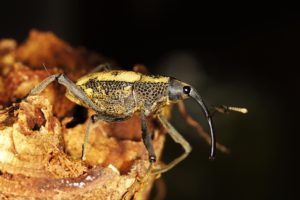Cannibalistic weevils
This big, handsome weevil is a Rhinastus sp. from Peru and the specimen here is the only one I have seen in the flesh. In 1928, the Portuguese agriculturalist Edmundo Navarro de Andrade revealed a remarkable nugget on the biology of these beetles, namely that their larvae are cannibalistic.
Andrade made this discovery when he was opening up a segment of bamboo. He found the larvae were numerous when small (six to 10 in each bamboo internode), but at a later stage there was only one large fat larva present. Andrade also watched a large larva eat a small one and he also reported that the Indians of Brazil considered the larvae a great delicacy.
He documented the adult female beetles laying eggs; puncturing the young bamboo shoots, always less than a year old and depositing one egg in each perforation. The eggs usually hatch within 6 to 10 days; 15 days being the maximum observed. Andrade also noted that in Rio Claro (state of Sao Paulo) that the adult beetles have been captured during different months of the year, but become more common during January and attain their maximum abundance during March.
Like any good biologist, Andrade also documented the mating behaviour of these beetles, noting that copulation is very prolonged and can continue up to 36 hours. After copulation the insects live, on an average, 7 to 8 days.
References
de Andrade EN (1928). Praga dos bambu’s (Rhinastus sternicornis (Germ.)). Arch. Inst. Biol. Sao Paulo, vol. 1, pp. 137-142, pls. 22, 23.
Vaurie P (1973). Revision of Rhinastus and description of a new species of Cholus (Coleoptera, Curculionidae, Cholinae). American Museum novitates, 2517: 1–17.

Leave a Reply